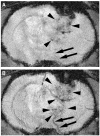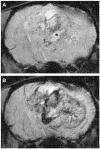High resolution ultra high field magnetic resonance imaging of glioma microvascularity and hypoxia using ultra-small particles of iron oxide
- PMID: 19448552
- PMCID: PMC2830862
- DOI: 10.1097/RLI.0b013e3181a8afea
High resolution ultra high field magnetic resonance imaging of glioma microvascularity and hypoxia using ultra-small particles of iron oxide
Abstract
Objectives: This study assessed whether ultra-small particles of iron oxide (USPIO) intravascular contrast agent could enhance visualization of tumor microvascularity in F98 glioma bearing rats by means of ultra high field (UHF) high-resolution gradient echo (GRE) magnetic resonance imaging (MRI). In an effort to explain differences in visualization of microvascularity before and after USPIO administration, hypoxia and vessel diameters were assessed on corresponding histopathologic sections.
Materials and methods: F98 glioma cells were implanted stereotactically into the brains of syngeneic Fischer rats. Based on clinical criteria, rats were imaged 1 to 2 days before their death with and without USPIO contrast on an 8 Tesla MRI. To identify hypoxic regions of the brain tumor by immunohistochemical staining, a subset of animals also received a nitroimidazole-based hypoxia marker, EF5, before euthanasia. These sections then were compared with noncontrast enhanced MR images. The relative caliber of tumor microvasculature, compared with that of normal brain, was analyzed in a third group of animals.
Results: After USPIO administration, UHF high-resolution GRE MRI consistently predicted increased microvascular density relative to normal gray matter when correlated with histopathology. The in-plane visibility of glioma microvascularity in 22 rats increased by an average of 115% and signal intensity within the tumor decreased by 13% relative to normal brain. Tumor microvascularity identified on noncontrast MR images matched hypoxic regions identified by immunohistochemical staining with a sensitivity of 83% and specificity of 89%. UHF GRE MRI was able to resolve microvessels less than 20 micro in diameter, although differences in tumor vessel size did not consistently account for differences in visualization of microvascularity.
Conclusions: USPIO administration significantly enhanced visualization of tumor microvascularity on gradient echo 8 T MRI and significantly improved visualization of tumor microvascularity. Microvascularity identified on precontrast images is suspected to be partly associated with hypoxia.
Figures







Similar articles
-
"Tumoral pseudoblush" identified within gliomas at high-spatial-resolution ultrahigh-field-strength gradient-echo MR imaging corresponds to microvascularity at stereotactic biopsy.Radiology. 2012 Jul;264(1):210-7. doi: 10.1148/radiol.12110799. Epub 2012 May 24. Radiology. 2012. PMID: 22627600 Free PMC article.
-
[MRI monitoring ultra-small superparamagnetic iron oxide (USPIO) particle labeling C6 rat glioma cells].Zhonghua Yi Xue Za Zhi. 2007 Jan 23;87(4):228-32. Zhonghua Yi Xue Za Zhi. 2007. PMID: 17425864 Chinese.
-
Dosage determination of ultrasmall particles of iron oxide for the delineation of microvasculature in the Wistar rat brain.Invest Radiol. 2005 Oct;40(10):655-60. Invest Radiol. 2005. PMID: 16189434 Free PMC article.
-
[Iron-oxide-enhanced MR imaging of inflammatory atherosclerotic lesions: overview of experimental and initial clinical results].Rofo. 2003 Apr;175(4):469-76. doi: 10.1055/s-2003-38434. Rofo. 2003. PMID: 12677500 Review. German.
-
Macrophage imaging in central nervous system and in carotid atherosclerotic plaque using ultrasmall superparamagnetic iron oxide in magnetic resonance imaging.Invest Radiol. 2004 Oct;39(10):619-25. doi: 10.1097/01.rli.0000135980.08491.33. Invest Radiol. 2004. PMID: 15377941 Review.
Cited by
-
Maintaining brain health by monitoring inflammatory processes: a mechanism to promote successful aging.Aging Dis. 2012 Feb;3(1):16-33. Epub 2011 Sep 30. Aging Dis. 2012. PMID: 22500269 Free PMC article.
-
Intratumor mapping of intracellular water lifetime: metabolic images of breast cancer?NMR Biomed. 2014 Jul;27(7):760-73. doi: 10.1002/nbm.3111. Epub 2014 May 5. NMR Biomed. 2014. PMID: 24798066 Free PMC article.
-
MRI using ferumoxytol improves the visualization of central nervous system vascular malformations.Stroke. 2011 Jun;42(6):1581-8. doi: 10.1161/STROKEAHA.110.607994. Epub 2011 Apr 14. Stroke. 2011. PMID: 21493906 Free PMC article.
-
"Tumoral pseudoblush" identified within gliomas at high-spatial-resolution ultrahigh-field-strength gradient-echo MR imaging corresponds to microvascularity at stereotactic biopsy.Radiology. 2012 Jul;264(1):210-7. doi: 10.1148/radiol.12110799. Epub 2012 May 24. Radiology. 2012. PMID: 22627600 Free PMC article.
-
The Continuing Evolution of Molecular Functional Imaging in Clinical Oncology: The Road to Precision Medicine and Radiogenomics (Part II).Mol Diagn Ther. 2019 Feb;23(1):27-51. doi: 10.1007/s40291-018-0367-3. Mol Diagn Ther. 2019. PMID: 30387041 Review.
References
-
- Burgess RE, Yu Y, Christoforidis GA, et al. Human leptomeningeal and cortical vascular anatomy of the cerebral cortex at 8 Tesla. J Comput Assist Tomogr. 1999;23:850–856. - PubMed
-
- Dashner RA, Kangarlu A, Clark DL, et al. Limits of 8-Tesla magnetic resonance imaging spatial resolution of the deoxygenated cerebral microvasculature. J Magn Reson Imaging. 2004;19:303–307. - PubMed
-
- Christoforidis GA, Bourekas EC, Baujan M, et al. High resolution MRI of the deep Brain vascular anatomy at 8 Tesla: susceptibility-based enhancement of the venous structures. J Comput Assist Tomogr. 1999;23:857–866. - PubMed
Publication types
MeSH terms
Substances
Grants and funding
LinkOut - more resources
Full Text Sources
Medical

